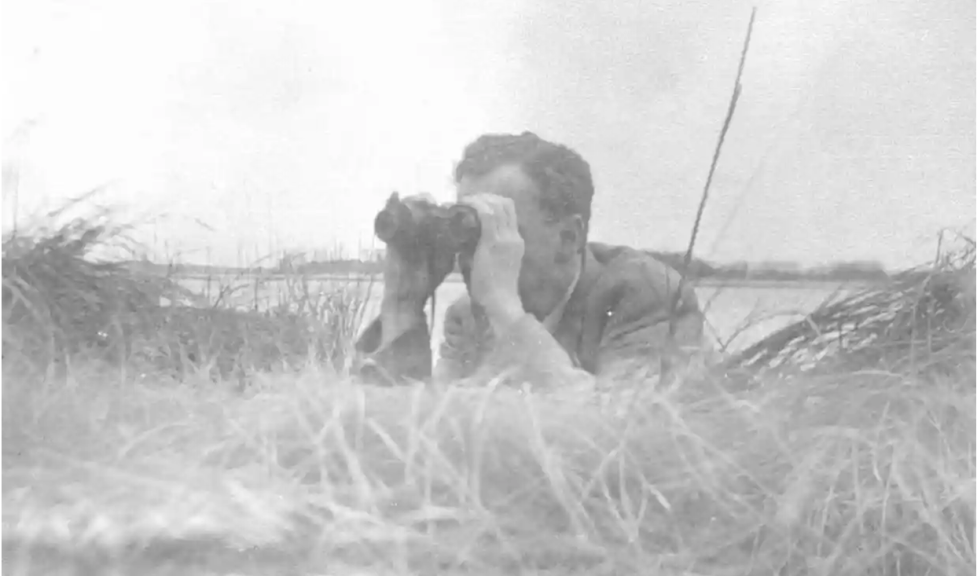Introducing BirdNote

Benjamin Britten birdwatching in Aldeburgh in the 1950s. PC: Britten Pears Arts
On September 2, Illinois Public Media is introducing a new daily show called BirdNote. Each two-minute episode illustrates the lives of birds with rich sounds and engaging stories, providing a moment of respite from the day’s news and deepening listeners’ connection with nature. The show will air weekdays at 5:58 am and 12:58 pm on WILL-FM 90.9. According to their website, BirdNote is “an independent media production organization that brings joy, inspiration, and hope to millions of people around the world who value birds and the environment we share.”
Birdsong can have a profound influence on our nervous systems, reducing anxiety and depression while improving self-regulation and overall well-being. Scientists posit that this is because birds only sing when the environment is free from danger, so hearing their songs signals peace and safety to us on a primal level. It is no surprise, then, that composers have long been inspired by the sounds of birds, incorporating their calls into music or painting them musically in some way. In this article, we’ll cover three composers who had a profound connection to these musicians of the natural world.
Jean Sibelius
There is perhaps no piece of classical music about birds more famous than “The Swan” from Saint-Saëns’ Carnival of the Animals. But Finnish composer Jean Sibelius (1865–1957) was also inspired by this majestic waterfowl and tried to capture its essence in multiple compositions. Sibelius often drew inspiration from nature, from the sounds of birds and insects to the play of water. His connection with the Finnish landscape was integral to his identity, just as he was integral to the burgeoning Finnish national identity.
First, there is the sweeping “Swan Hymn” in the final movement of Sibelius’ Fifth Symphony. This melody was inspired by a breathtaking experience Sibelius had one April day in 1915: “Today at ten to eleven I saw sixteen swans,” he wrote in his diary. “One of my greatest experiences! Lord God, what beauty! They circled over me for a long time. Disappeared into the solar haze like a gleaming silver ribbon.” The resulting “Swan Hymn” is a swinging horn motif that evokes the graceful beating of the swans’ wings, while the woodwinds’ countermelody suggests their call. (You can listen to a BirdNote episode about this stirring musical moment here, and listen to the "Swan Hymn" below, which begins at 1:20.)
In Finnish mythology, swans can play a more sinister role. In the Kaleva, a collection of epic poetry from Karelian and Finnish oral folklore and mythology, a swan guards Tuonela, the land of the dead. Akin to a Finnish Hades, Tuonela is surrounded by a dark, wild river. In the story, the heroic adventurer Lemminkäinen has come to kill the swan in an effort to woo the daughter of a sorceress. In his attempt, he is mortally wounded and falls into the river of death.
Sibelius captures the serene but ominous atmosphere of Tuonela in Tuonelan Joutsen (“The Swan of Tuonela”). The music is slow-moving to the point of near immobility, evoking the incantatory repetitiveness of the runic singing used to transmit the Kalevala poetry. The melancholy English horn embodies the voice of the swan in a famous solo that extends through most of the movement.
Olivier Messiaen
French composer Olivier Messiaen (1908–1992) had a lifelong preoccupation with songbirds, calling them “small servants of immaterial joy” and “the greatest musicians on our planet.” He would go into the field all hours of the day and night to take precise dictation of the birds he heard, becoming a highly respected ornithological expert. As a synesthete (meaning he saw colors when he heard music), Messiaen processed sound in a unique way. This ability likely contributed to his fascination with not only the melodies of the birdsongs but also their timbres and the sounds of their surroundings.
Although he evoked birdsong in earlier works, beginning with Quatuor pour la fin du temps (1941), he began to write music based on his precise ornithological notations in the 1950s. Catalogue d’oiseaux (1956–58) is his first of three ornithological works for solo piano. The cycle is composed of 13 pieces split into seven books, with each piece given the name of a bird from the French provinces, from the tiny woodlark to the common buzzard. Messiaen explains in the work’s subtitle, “Each soloist is presented in its habitat, surrounded by its landscape and by the songs of other birds (77 in all) from the region.” He was extremely proud of the exactness of his transcriptions, writing, “All here is truth, even the countryside with all its accompanying sights, sounds, smells and thermal currents.” To further illustrate the scenes, Messiaen provides an introductory poem to each movement and vivid descriptions throughout the score. (You can read Messiaen’s full notes here.)
Benjamin Britten
Benjamin Britten (1913–1976) was an advocate for environmental protection before it was cool. The British composer was constantly inspired by the seascapes, marshes, and wildlife of his native Suffolk. In fact, he once said of his hometown, Aldeburgh, “all the music I write comes from it.” He was an avid birdwatcher and a member of the Royal Society for the Protection of Birds (RSPB). He proudly displayed his RSPB member badge on his car and even gifted memberships to friends over the years. Not only does the natural soundscape of Suffolk, including the birds Britten would have heard on his daily composing walks, suffuse his compositions, but he also incorporated concerts, lectures, and films on environmental topics into the programming of the Aldeburgh Festival (an annual music festival he founded in 1948 with his partner, Peter Pears, which still runs today). For instance, lectures on nature protection, bird life in East Anglia, beachcombing, and wildlife preservation in Africa were presented alongside numerous RSPB films.
If you listen to Britten’s Four Sea Interludes from his 1945 opera Peter Grimes, not only will you hear the swelling sea and tolling church bells but also the sound of birds native to the Suffolk coast where the opera is set. For instance, the opening violin and flute theme of the first interlude, “Dawn,” with its spontaneity, trills, and soaring melodic contour, might represent a lonely bird’s call on a cold morning. Finally, the rest of the birds wake up, depicted in the chirpy woodwinds of the second interlude, “Sunday Morning.”
Bonus listening: Check out “Cuckoo” by Cosmo Sheldrake, a rendition of Britten’s “Cuckoo Song” from Friday Afternoons (1933–35), a collection of songs written for children. In this version, Sheldrake mixes in the sound of a cuckoo singing above Britten’s grave in Aldeburgh Cemetery, recorded by the soundscape ecologist Bernie Krause.



